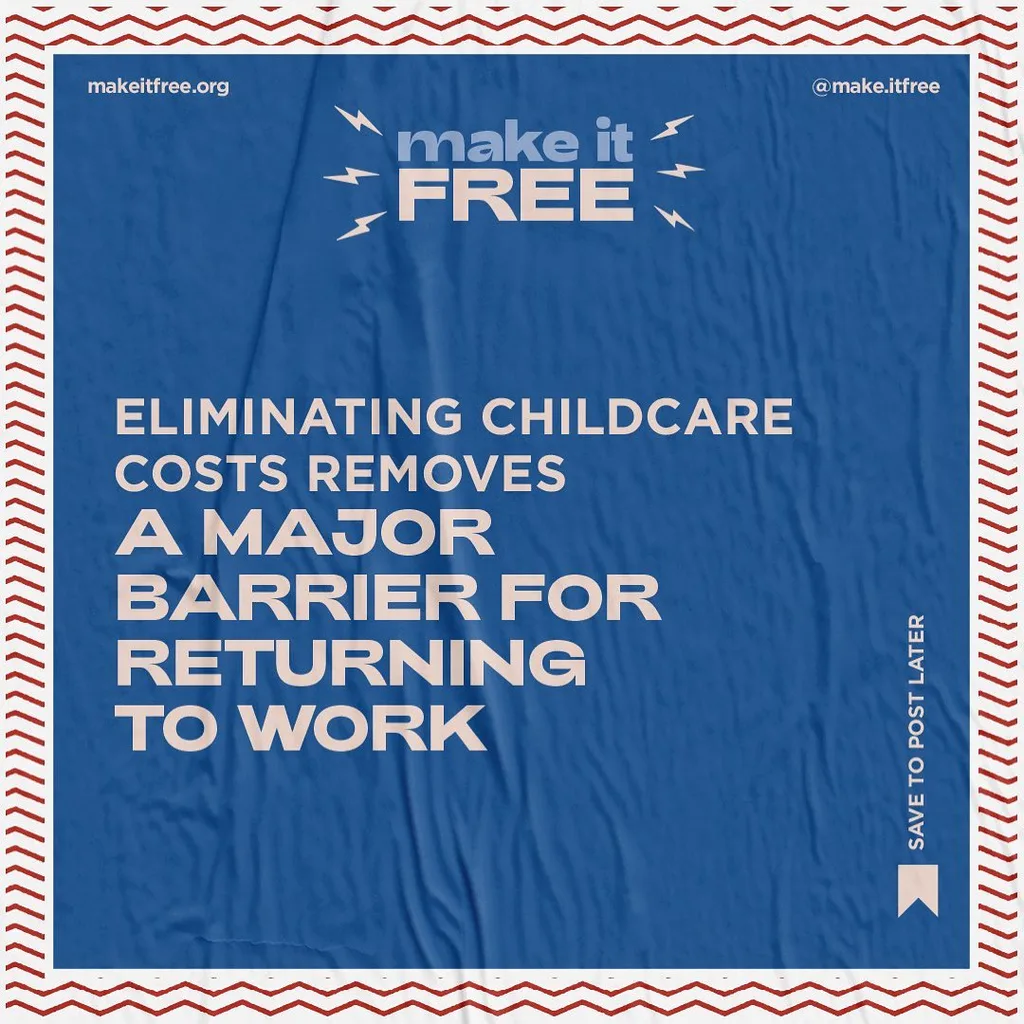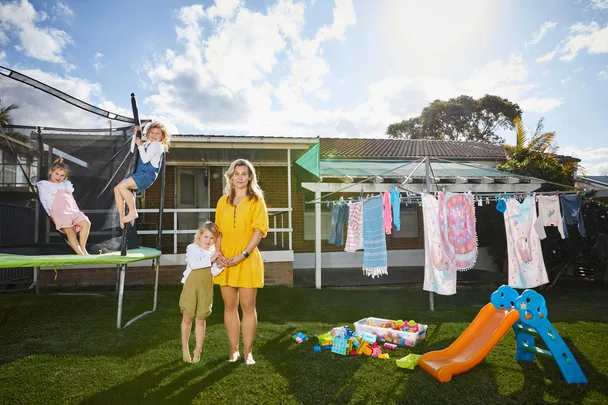Having worked in finance for almost 20 years, Nichole Alexander isn’t averse to running her eyes over a spreadsheet populated with numbers. But there’s one figure the Sydney-based mum of three has studiously avoided for seven years: exactly how much she and her husband, a builder, have spent on childcare for their daughters.
“At our peak when all three girls were in long daycare we were spending more than $1300 a week.” Alexander says. “We’ve spent more than $300,000 after tax on childcare.”
They tried many combinations– long daycare, family daycare and a nanny – at different times, but no matter the solution, two factors remained: the juggle was immense and the cost was eye-watering.
“I’m in an absolute minority as a 38-year-old woman, working full-time in banking with three kids, and I know that’s because it’s too hard and too expensive,” Alexander explains. “I’m ahead in my career because I’ve continued to work, but from a financial perspective, whether I had worked or not, there’s barely any difference.”
If it hadn’t been for a timely piece of advice from an older female boss, Alexander admits she may have resigned. “One of my mentors said: ‘You might not be making anything right now, you might even be in the red, but think about your super,’” she recalls. “That was persuasive … but if you don’t love your job or it doesn’t pay well, why would you persevere with the juggle? Because it effectively means you are paying to work.”

The case for radically overhauling childcare has been fought for decades. Since the 1970s, it has consistently been a top priority for women’s rights activists, yet little has changed. Fees for childcare in Australia grew by a staggering 145 per cent between 2002 and 2017, and now absorb nearly one-fifth of many Australian families’ incomes. This year’s pandemic has made things even harder for already stretched working mothers, highlighting a broken system that is costing women their salaries and their careers.
“Invariably, it is the mums who drop their work to look after children when childcare becomes unaffordable, and that’s because the reality is that women earn less in Australia than men do,” says early childhood education consultant Lisa Bryant. “When heterosexual families need to work out who works and who doesn’t, too often it makes more financial sense for it to be the mother who steps back. That’s the pattern that has been followed and replicated for decades.”
The high cost of childcare explains Australia’s strangely low rates of women participating in the workforce – despite them being highly educated. The World Economic Forum examines how nations are tracking when it comes to equality between the sexes. Its annual Global Gender Gap Report measures the gap between men and women in four areas: education, health, political empowerment and workforce
participation. When the first report was published in 2006, Australia ranked a respectable 15th, but every year since it has steadily dropped further behind. In 2019, Australia ranked 49th out of 153, placing it behind countries including Cambodia, Sierra Leone and Kazakhstan for women’s workforce participation.
The dismal numbers reflect a bigger issue at play: the presumption that men will be breadwinners and women will be caregivers. It’s a notion that is still “very ingrained in Australia”, says political journalist and commentator Annabel Crabb. “Women’s lives have changed considerably since the 1950s … we’ve flooded into the workforce and changed the way we live, commonly juggling work and family, moving in and out of work as our life circumstances
change,” says Crabb, who has analysed gender dynamics in her books The Wife Drought and Men at Work. “But for men, there hasn’t been a huge change.

Men are much more likely to work fulltime for their whole lives. Which is why, when you look at the division of work in the home, women on average do nearly twice as much as men.”
Half a century ago, in 1970, an average of 17 weeks of paid leave was available to mothers across OECD countries (the term given to the group of 37 countries that stimulate economic progress and world trade). By 1990, this had increased to 39 weeks, and by 2018, the OECD average stood at just under one year of paid leave for every new mother.
In 2020, Australia offers up to 18 weeks of paid leave at the minimum wage. “If you have a look at how the leave is presented, the primary carer scheme is directed at women, while the ancillary two-week scheme is called Dad and Partner Pay,” Crabb explains. “It couldn’t be clearer who the primary carer is supposed to be.”
Crabb continues: “You have to look at who’s making the decisions at a leadership level. In the Cabinet, all the key economic decisions are made by the Expenditure Review Committee. There is not one woman on that five-member group. Every man on there has a wife who is the primary carer. Which is what works for their families – I get it – but it does mean the life experience of the decision-makers is fairly narrow.”
Whether by accident or design, economists say policy settings that enable traditional gender roles to prevail cost Australia dearly. The Grattan Institute released new research in August that showed spending an additional $5 billion annually on making childcare more affordable would deliver an $11 billion boost per year to the Australian economy, predominantly by facilitating more women to work.
“We can hardly be surprised that many mothers conclude that working an extra day for no or virtually no take home pay makes no sense,” says Danielle Wood, CEO of The Grattan Institute. “Australia’s high out-of-pocket childcare costs bite even harder now for families who have lost jobs or hours because of the COVID crisis. It should be central to the government’s plans for lifting Australia out of recession.”
In April, Prime Minister Scott Morrison made childcare free for families for three months to try to combat the financial turmoil triggered by the coronavirus. The bold intervention came in response to families removing their children from childcare in unprecedented numbers as they faced job losses and health risks. Plummeting enrolments pushed childcare services to the brink financially and the sector was at risk of collapse.
“While the ‘fee-free’ package was flawed and put financial pressure on many services and educators, it kept services open and was historic,” says Bryant. “Overnight, a conservative federal government showed that radical reform like making early childhood education and care free to parents was not just possible, but necessary.”
For Rebecca Browder, a Perthbased lawyer and mum of two, the difference even three months of free childcare made in her household was huge. “About 60 per cent of my salary goes on childcare, so not paying fees was like a pay rise,” she says. “It was incredible. We used the money to fix the air conditioning at home and get our car serviced, both things we’d been putting off because we couldn’t previously afford them. And we both earn a good living.”
After having their son, Henry, four years ago, Browder returned to work three days a week. “When we looked at the cost of childcare and what would work for us as a family, we decided that working three days a week was the best option,” she says. Following the birth of their daughter, Lillian, now 18 months, Browder trialled working four days because she knew it would be more beneficial from a career perspective. “But we were losing money – our childcare bill was going to be $40,000 for a year,” she explains. After six months, she cut back to three days a week. “We just couldn’t justify it.”

The salt in the wound for Browder is having two sisters who work as early educators and struggle to make ends meet. “They’re some of the lowest-paid workers in Australia,” she says. “The childcare system exploits women in two ways: it exploits mums who are trying to get back to work and it exploits the women who work in early education.”
Thankfully, there are some positive indicators that change is on the agenda. Australian billionaires Nicola and Andrew “Twiggy” Forrest are looking to overhaul the system via their philanthropic venture, The Minderoo Foundation. They have set up Thrive by Five, an initiative aimed at giving Australian children the best start to life, with a focus on access to high-quality early education for all children.
Former South Australian Premier Jay Weatherill heads up Thrive by Five and feels the pandemic has provided an opportunity for change. “COVID has revealed how precarious our system of childcare is,” Weatherill said.
“This represents a massive opportunity for the nation to rebuild probably its most important service system. The long-term effect of the early years on education, health and economic productivity trajectories is irrefutable.”
Weatherill points out that the “extraordinary benefits” to children accessing high-quality early education in their first five years of life – as well as the positive economic benefits associated with facilitating Australian women working to their fullest capacity – constitute compelling grounds for change. “A more effective childcare system would constitute a significant economic reform that would transform many Australian families, the national economy and society,” he says.
Dee Behan and Carlie Logie, both mums who run their own businesses, were compelled to push for reform after experiencing the reprieve from childcare fees earlier this year. “The cost of childcare is so high in Australia that it is a real barrier for parents who run businesses,” says Behan, co-founder of the lifestyle brand Frankly Co. “The devastating economic impact caused by COVID has just exacerbated how unaffordable it is, while simultaneously proving how essential it is.”
While free childcare threw these women a lifeline while they both worked furiously to keep their businesses afloat, “having it taken away, in the middle of a massive economic crash, was devastating,” says Logie, the principal designer at Logie Interiors. “After eight long, hard years, I have established myself within the industry. The idea of having to walk away because of the exorbitant costs of childcare is sad and deflating.”
Instead of conceding defeat, Logie and Behan channelled their frustration into lobbying for reform. Their campaign, Make It Free, launched in August and in less than a week, more than 130 businesses and 1000 parents had joined the movement. Says Behan: “You don’t have to be a parent or a business owner to see that making childcare free makes sense, but as both a mum and an entrepreneur trying to save my business during a pandemic … I hope it happens.”
Ways to Create Change
JOIN The Parenthood and Make It Free
SIGN UP to Thrive By Five
WRITE to your local member and let them know how the high cost of childcare affects you
SPREAD the word among your friends, colleagues and family that other countries offer high-quality, affordable early education and care for children, and Australia needs to follow suit.
This article originally appeared in marie claire Australia’s November 2020 issue.
 Alana Landsberry/marie claire Australia
Alana Landsberry/marie claire Australia









